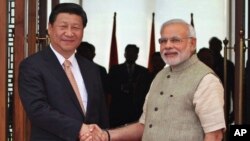The leaders of India and China meet Friday amid tensions along their contested border and a rivalry for influence among their smaller neighbors that could determine dominance in Asia.
Chinese President Xi Jinping is to sit down with Indian Prime Minister Narendra Modi in the central city of Wuhan at the start of two days of talks between the heads of the world’s two most populous nations.
The Indian Ministry of External Affairs spokesman Raveesh Kumar said Modi arrived after midnight in Wuhan. The leaders would “review the developments in our bilateral relations from a strategic and long-term perspective,” Kumar said in a tweet.
China-India relations date back centuries but in recent decades have been characterized by competition for leadership in Asia.
Some of the issues
The countries fought a border war in 1962 and last year engaged in a 10-week standoff in the neighboring state of Bhutan. India has also been alarmed by China’s moves to build strategic and economic ties with Indian Ocean nations including Sri Lanka, the Maldives and India’s longtime rival Pakistan.
China for its part resents India’s hosting of exiled Tibetan spiritual leader, the Dalai Lama, and its control of territory Beijing says belongs to it.
China claims some 90,000 square kilometers (35,000 square miles) of territory in India’s northeast, while India says China occupies 38,000 square kilometers (15,000 square miles) of its territory in the Aksai Chin Plateau in the western Himalayas. Officials have met at least 20 times to discuss the competing border claims without making significant progress.
Following the most protracted standoff in years, India last year agreed to pull back troops from the disputed Doklam Plateau high in the Himalayas, where Chinese troops had started constructing a road.
Economic possibilities
Despite such differences, Modi hopes China can help drive Indian economic growth ahead of national elections next year. However, his administration has been reluctant to engage with Beijing’s “Belt and Road” initiative linking its economies to those of Asia, the Middle East, Africa and Europe.
Modi will be traveling to China again in June for the Shanghai Cooperation Organization summit. Along with China and India, that group includes the Central Asian states of Kazakhstan, Kyrgyzstan, Tajikistan, Uzbekistan as well as Pakistan.









